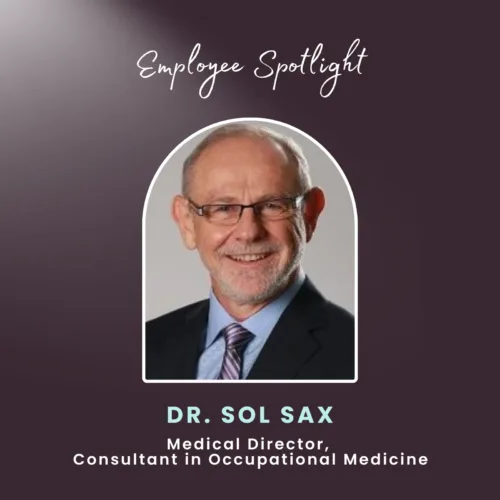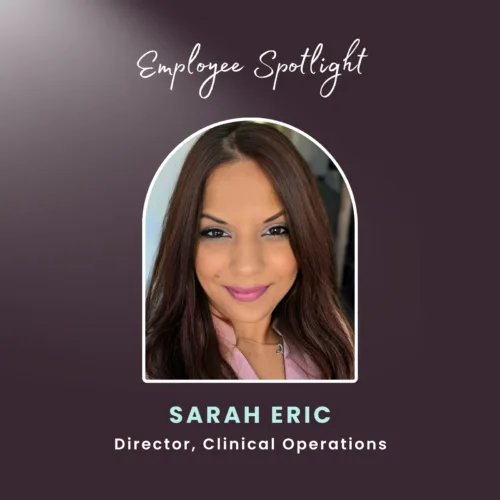Employee Spotlight: Dr. Sol Sax

5 Minute Read
Dr. Sol Sax, BAsc, MD, FRCPC, CCBOM, Medical Director, Consultant in Occupational Medicine
Meet Dr. Sol Sax, Kii Health’s Medical Director and Consultant in Occupational Medicine. He brings decades of experience as an occupational physician, including as the Medical Director – Canada for industry leaders, such as GE Healthcare and GE Vernova, and has been part of internationally renowned committees and advisory boards, including serving as a Medical Consultant to the Ontario Workplace Safety and Insurance Board, making him an invaluable asset at Kii Health.
With a focus on clinical leadership, quality assurance, and strategic growth, Dr. Sax plays a vital role in shaping and supporting our occupational health programs. He works closely with our team of physicians and on-site nurses to ensure high-quality, confidential care that meets both legal and corporate standards. Whether it’s identifying new service opportunities, developing tools to enhance efficiency, or helping integrate care across our offerings, Dr. Sax brings both vast clinical expertise and strategic insight to everything we do.
1. What do you see as the most pressing health and wellness challenges facing employees today?
Mental health is at the top of everyone’s list. Trying to find balance in one’s life, be effective at work, deal with life’s stressors, and have energy left for personal and family activities – this is something many people are struggling with in today’s environment.
2. In your opinion, why is it important for employers to take a proactive approach to employee health and wellness?
There is no doubt that a proactive approach to employee wellness helps people be more productive and decreases absenteeism and presenteeism (working while not fully functioning due to illness, injury, etc.). I have seen time and time again how much of a difference it can make when organizations proactively prioritize their workforce’s health and well-being. Focusing on employee health and wellness also positions the employer to attract the best employees, since many people, especially younger employees, value these types of programs. It’s a win-win scenario for both employers and employees.
3. What role does medical oversight play in creating safer and healthier workplaces?
Occupational physicians are focused on prevention. We look for workplace hazards, including physical and psychosocial (the potential to negatively impact mental or emotional well-being) hazards, and provide recommendations on how best to mitigate adverse effects from those hazards.
4. From a clinical perspective, what are the advantages of having healthcare professionals embedded directly within an organization’s workforce?
Unlike physicians and nurses in the community, healthcare providers embedded within an organization understand the workplace risks and have relationships in the workplace, including with management, human resources, and health and safety teams. This enables them to create more tailored solutions to health problems that meet both the employees’ needs and the business’s needs.
5. How does Kii Health’s occupational health solution stand out in supporting both employers and employees?
What sets Kii Health apart is that our specialty encompasses both preventive and clinical, with a strong focus on supporting the whole person physically, mentally, and emotionally. We help individual employees navigate and overcome their unique health challenges, so they can be their best selves. These interactions also generate group-level data and insights, which we can then analyze to get a better handle on health challenges affecting the larger population of employees. By seeing “the big picture,” we can then advise on more targeted programs and services that benefit the entire workforce.
However, our occupational health solution is just one piece of the puzzle. Because health is never one-dimensional, Kii Health’s solutions bring together a full range of services that support employees’ mental, physical, and emotional well-being. From EFAP and mental health coaching to disability management, healthcare navigation, and virtual medical care, we meet employees where they are and guide them to the care they need.
6. Are there any examples you can share of how early intervention or on-site care made a real difference for an employee or employer?
I have worked with many different organizations, but there is one example that stands out to me. For one of our clients, we have access to weekly, employer-paid counselling programs that help employees manage their work or personal stressors. I recently assessed an employee who was feeling depressed and anxious after a personal loss, and thankfully, the individual identified to the on-site nurse right away that they were struggling at work. By referring them to a counselor that they could see weekly, they received tools to help them deal with the loss. Our team was also able to work with the employer on workload accommodations, and as a result, the employee was able to continue being productive at work, without needing to take a potentially lengthy mental health leave. This is just one of many examples where early intervention made a significant positive impact for both the employer and the employee.
7. What’s one piece of advice you’d offer to organizations looking to better support their workforce’s health and safety?
From my experience, the best solution comes from looking at all the pieces of the puzzle and how they come together. First, you have to understand the business risks and needs, and the employee risks and needs, and find the points of intersection or overlap. Once that is established, we can help create a plan that addresses any gaps and create a timeline to address those.
8. How do you think workplace needs are evolving when it comes to health and wellness support?
Honestly, from what I have seen over the past few decades, I think workplace needs have not really evolved. They were always there. What has changed is the area of focus. We used to focus mainly on physical hazards, such as dust, chemicals, noise, etc. Now, with fewer people in high-risk manufacturing jobs and many more knowledge workers, the shift has been to understand and manage mental health and psychosocial hazards – so much so that we now even have a Canadian standard for Psychological Health and Safety in the Workplace.
At the same time, workplace stress has been further compounded by the business need for ever-increasing productivity (doing more with less), as well as job and economic insecurity that we’re seeing more and more due to bankruptcies, mergers, layoffs, restructuring, etc. All of that to say, the need for mental health support has always been there; what’s changed is how much focus organizations are now placing on employees’ mental. At Kii Health, we’ve adapted to meet this shift head-on. Our mental health support is embedded across the continuum of care, whether it’s through early intervention services like EFAP and mental health coaching, or more intensive support from registered clinicians. By making access simple and stigma-free, and by integrating mental health into the overall strategy for employee well-being, we help organizations address today’s most pressing workplace risks with compassion and clinical excellence.
To hear more from Dr. Sax, check out this webinar in honour of World Mental Health Day 2024, where he teamed up with Dr. Khush Amaria, Clinical Psychologist and Kii Health’s VP of Clinical Services – Mental Health, for an insightful discussion about how to manage stress and maintain well-being through periods of change and uncertainty: Mind and Body Health: Building Wellness and Engagement During Organizational Change and Economic Uncertainty.


